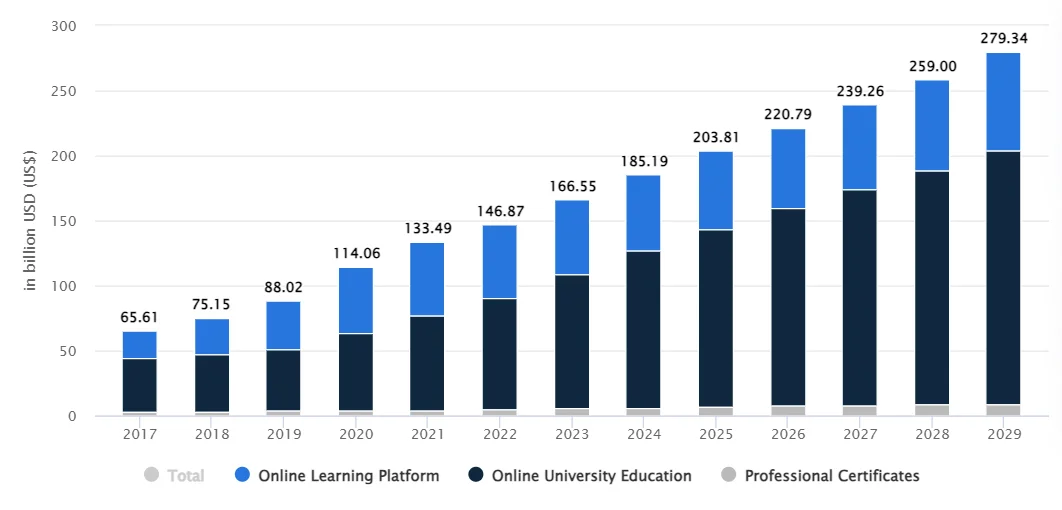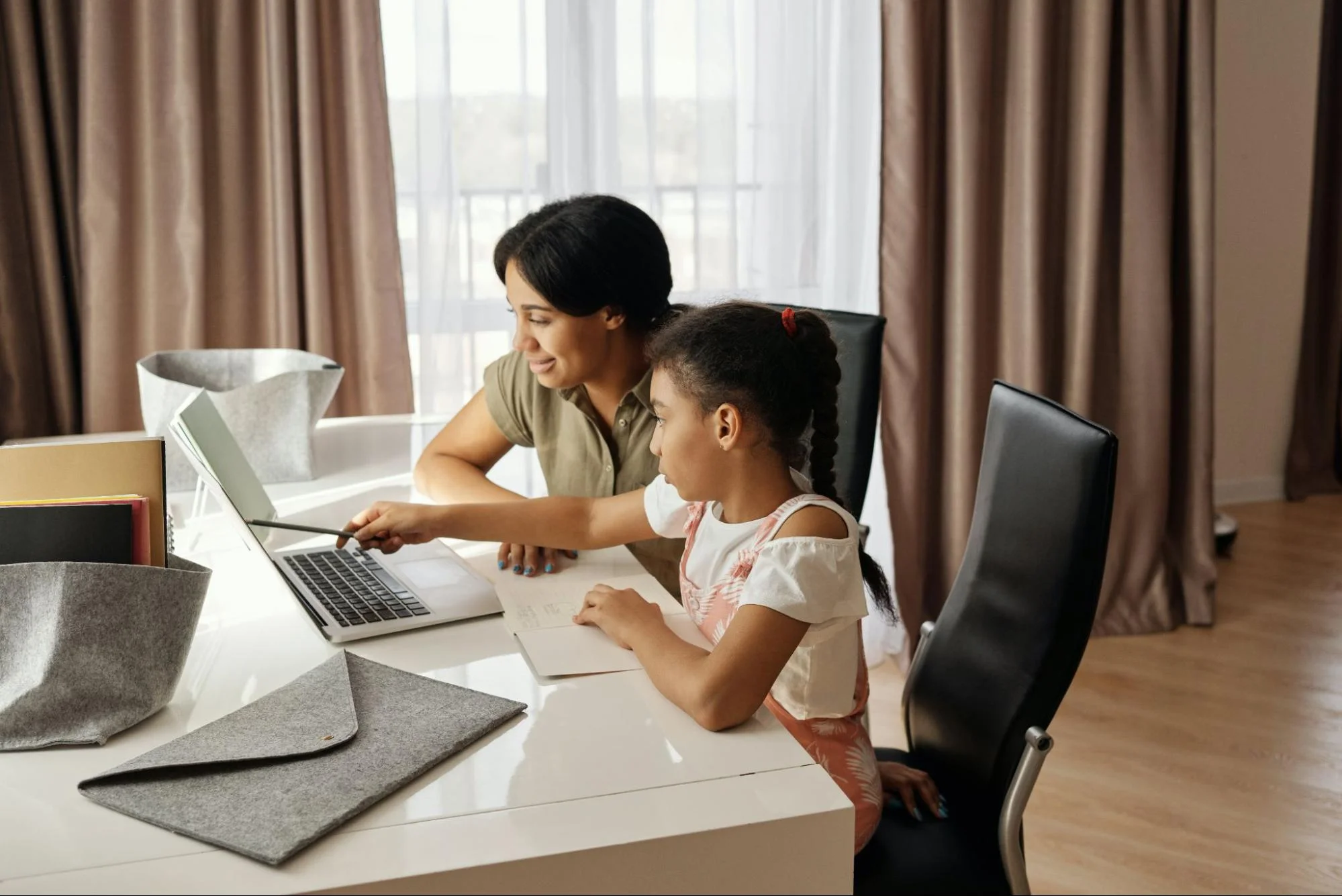Update: This article was last updated on 5th August 2024 to reflect the accuracy and up-to-date information on the page.

For around 500 years, humans have collectively failed to bring a defining revolution in the educational sector. We went from bullock carts to airplanes but could not take our kids from a traditional classroom environment to a more inclusive and interactive one.
But it’s time for a change.
Our children are growing up in an era where information is accessible at their fingertips and where the ability to adapt, innovate, and collaborate is paramount. Online education offers a gateway to this new era of learning, enabling us to tailor education to our kids’ needs, preferences, and diverse learning styles.
According to a report by Statista, nearly 63% of US students are utilizing online learning resources regularly. The data by Coursera is also promising, with the US topping the standings with more than 17 million people enrolling in online learning, followed by India with 13.6 million.
One of the key advantages of online learning lies in its ability to significantly enhance learners’ retention rates, ranging from 25% to an impressive 60%, surpassing the more traditional approach of one-on-one tutoring, which typically yields retention rates of 8% to 10%.

In the Online Education market, the number of users is expected to amount to 1,121.0m users by 2029. User penetration in the Online Education market will be at 14.9% in 2024.
This is primarily attributed to the flexibility online learning offers, enabling students to revisit and reinforce their understanding at their own pace, thus granting them greater control over their learning journey.
When we think of younger segments, of what we are targeting: 7–16-year-olds – online alone with synchronous, pre-recorded videos doesn’t work because only so many students will have motivation. That number sits under 5%, where they can go through the journey by themselves.
Students need several things, such as
- Continuous maneuvering
- Monitoring
- Appreciation
- Support
- Inspiration
Inspiration happens, say, limited incidents by teachers, but a lot of inspiration happens if same-age students surround kids, and that’s why Moonpreneur offers classroom sessions. So, these are online classes but synchronous instructor-led in a cohort format.
So they have, let’s say… These are technical sessions. They have another five or six students sitting, the same age, with a similar learning pattern. Some students learn fast; some go for a slow pace, and things like that. This is very important, and this is only possible when we bring online instructor-led synchronous learning, especially for 7 to 16-year segments.
Replicating the same thing in a brick-and-mortar setup is difficult because we currently have several thousand students. We can create batches based on their prior knowledge, learning patterns, age, and all kinds of things because we have a lot of choices to pick from.
We are creating anywhere from 25 to 30 batches of new batches every month. So, a lot of flexibility is there.
Imagine, in a brick-and-mortar setup, we have two or three sections, barely 50 to 70 students to pick from. Indeed, it isn’t easy to create anything like this.
Synchronous and asynchronous sessions like pre-prep and post-prep or revision, which are only recorded, can do wonders. We have already seen what numbers look like regarding retention rate.
This kind of synchronous hybrid learning is the future of education, especially for the younger segment. Consider accessibility and inclusivity; online learning is available to anyone regardless of location or socioeconomic status. Our primary focus is the US market, but soon, we would like to take it across the globe.
Personalized learning path – we can create all these batches based on many criteria. In this way, online learning can be tailored to meet each student’s individual needs and learning styles, where they can still have inspiration and company, but things are running at their pace.
This way, you bring more efficient skill development. It can be more efficient this way – online learning than traditional classroom as students can learn at their own pace and focus on the skills they need to develop. This gives a lot more flexibility.
The global exchange or global exposure – right now, we have many cohorts where students are joining from the UK, Canada, the US, India, Africa, and other places. In a traditional classroom atmosphere, it’s not possible. And the world is more global than ever, and it will get even more aggressive there.
Flexible Learning

Both the teacher and the student can choose their own learning speed when they receive their education online, and there’s also the added benefit of scheduling classes around everyone’s schedules. It is therefore possible to better mix work and study by using an online educational platform, so there is no need to give anything up. Finding a solid work-study balance is made easier by the time management skills you learn from studying online. A shared agenda between the instructor and the student may also encourage both to take on more responsibility and autonomy.
Interactive Learning

Online learning can be more interactive than traditional classroom learning. Students can participate in the discussion, collaborate on projects, and interact with their teachers and classmates in real-time. Their exercises can be tailored, and much data can be collected and provided as feedback for their learning mechanism. So it can be more efficient, flexible scheduling and learning pace. It can be much more flexible than traditional room learning, as students can choose when and where they want to learn.
And then data-driven insights – all the online learning platforms can collect data on students’ progress, which can be used to improve the learning experience and identify areas where students need additional support. The individual data collection on the learning pattern is almost impossible in a traditional classroom setup.
Online education, especially the synchronous one, can potentially transform the educational landscape for the younger segment. It can give students the skills they need to succeed, especially in this 21st-century workforce. It can help them develop into well-rounded students or individuals can help them for their future education, college admission, and future of work.
More will come soon.
Moonpreneur is on a mission to disrupt traditional education and future-proof the next generation with holistic learning solutions. Its Innovator Program is building tomorrow’s workforce by training students in AI/ML, Robotics, Coding, IoT, and Apps, enabling entrepreneurship through experiential learning.
























Why is everyone talking about a revolution in education?
Traditional education is facing challenges like rigid schedules, limited resources, and personalized learning limitations. Online learning offers flexibility, accessibility, and diverse content, shaking up the way we learn and potentially transforming the entire education landscape.
But isn’t online learning just sitting in front of a screen all day?
Not anymore! Today’s online learning platforms are interactive and engaging, with multimedia content, interactive exercises, and collaborative tools. It also encourages self-paced learning and caters to diverse learning styles.